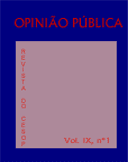Resumen
A Bélgica tem a peculiaridade de ser o único Estado-membro da UE a ter introduzido cotas em sua legislação. O tipo de cota que foi implementada prioriza o número, sem dar atenção a como candidatos masculinos e femininos estão posicionados nas listas dos partidos. Neste artigo, a autora examina a evolução do número de mulheres no Parlamento belga ao longo do tempo. Fazem-se comparações dentro dos partidos e entre eles, antes e depois da lei sobre cotas. A análise mostra que, em larga medida, o efeito das cotas depende da vontade dos partidos de obter mais representantes do sexo feminino. Assim, se o principal objetivo de uma legislação sobre cotas é impor uma estrutura de gênero equilibrada na assembléia de representantes, a legislação precisa considerar as posições dos homens e das mulheres nas listas.
Abstract
Belgium has the particularity of being the only EU Member State to have introduced quotas to its legislation. The type of quota which has been implemented is prioritizing the number, without paying attention to how male and female candidates are positioned on the parties' lists. In the article the author examines the evolution of the number of women in Belgian Parliament across time. Comparisons are made within and between parties, before and after the law about quotas. The analysis shows that the effect of quotas to a large degree is dependent on the will of parties to obtain more female representatives. Thus, if the major aim of a legislation on quotas is to impose a balanced gender structure in the representatives’ assembly, the legislation ought to consider men’s and women’s positions on the lists.
Key words: candidates, quotas, party lists, Belgium Parliament, representation
Citas
CAUL, M. 1999. “Women's Representation in Parliament. The Role of Political Parties”, Party Politics, 5(1) 79-98.
CELIS, K., et al..1998. «Femme et politique en Belgique ». Sophia, 16, dezembro.
CHAMPAGNE, P. 1990. Faire l'opinion. Le nouveau jeu politique, Paris, Ed. Minuit.
COENEN, M.-T. 1998. ”Les femmes font-elles partie de la nation?”, in H. PEEMANS-POULLET (ed.) La Démocratie à l'épreuve du Féminisme. Bruxelas, Université des Femmes, pp. 19-47.
DAHLERUP, D. 1988. “From a Small to a Large Minority: Women in Scandinavian Politics”. Scandinavian Political Studies, 11(4).
DESCHOUWER, K., DE WINTER, L. e DELLA PORTA, D. 1996. “Partitocracies between crises and reforms: The cases of Italy and Belgium”. Res Publica, 38(2).
DUVERGER, M. 1955. La participation des femmes à la vie politique, Paris, Unesco.
GUBIN, E.1998. « Le suffrage féminin en Belgique (1830-1921). Arguments et enjeux”. in H.
PEEMANS-POULLET (ed.) La Démocratie à l'épreuve du Féminisme. Bruxelas, Université des Femmes, pp. 49-75.
GUBIN, E. e VAN MOLLE, 1998. L. Femmes et politique en Belgique. Bruxelas, Editions Racine.
HELD, D. 1997. Models of Democracy. Polity Press, Cambridge.
KAISER, P. 1999. “Party Incentives and Women’s Parliamentary Participation: A Comparative Study of Six OECD Countries”. Trabalho apresentado na Reunião Anual da American Political Science Association, setembro.
MANIN, B. 1995. Principes du gouvernement représentatif, Paris, Flammarion.
MARQUES-PEREIRA, B. 1998. « La Parité: Les Termes Du Débat », IN H. PEEMANS-POULLET (ed.) La Démocratie à l'épreuve du Féminisme. Bruxelas, Université des Femmes, pp. 175-191.
MATEO DIAZ, M. e AISH, A.-M. 1999. « Femmes et démocratie. Les attitudes des électeurs wallons à l’égard des femmes en politique », in A.-P. FROGNIER e A.-M. AISH (eds.), Des élections en trompe-l’œil. Bruxelas, De Boeck, pp. 121-159.
NORRIS, P. 2000. “Breaking the Barriers: Positive Discrimination Policies for Women”, in J.
KLAUSEN, e C.S. MAIER, Has Liberalism Failed Women? Parity, Quotas and Political Representation. Nova York, St Martin's Press.
NORRIS, P. e LOVENDUSKI, J. 1995. Political Recruitment. Gender, Race and Class in the British Parliament. Cambridge, Cambridge University Press.
UNION INTERPARLEMENTAIRE. 1992. Les Femmes et le Pouvoir Politique. Enquête menée auprès des 150 Parlements nationaux existant au 31 octobre 1991, Genebra, Rapports et Documents N°19.
UNION INTERPARLEMENTAIRE. 1995. Les Femmes dans les Parlements 1945-1995 Etude statistique mondiale, Genebra.
VERDUSSEN, M. 1998. « La participation des femmes aux élections en Belgique ». Revue française de Droit constitutionnel, 36.
VERDUSSEN, M. 1999. « La parité sexuelle sur les listes de candidat(e)s ». Revue belge de Droit constitutionnel, 1.
VERZELE, V. e JOLY, C. 1999. « La représentation des femmes en politique après les élections du 13 juin 1999. Evaluation de l'application de la loi Smet-Tobback ». Courrier Hebdomadaire du CRISP, 1662-63.
A Opinião Pública utiliza a licença do Creative Commons (CC), preservando assim, a integridade dos artigos em ambiente de acesso aberto.

